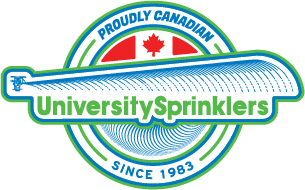Rainwater Harvesting
Irrigate with free water that falls from the skyRainwater Irrigation Systems:
Irrigate with free water that falls from the sky!
Rainwater harvesting is not a new concept. For thousands of years, people have been collecting rainwater. This simple technology continues to be used today around the world to provide water for drinking, irrigation and other non-potable uses. Collection systems range from 10,000-gallon cisterns to 40-gallon rain barrels.
The City of Abbotsford collects over 868,000 litres of water every year with their tanks. This water is then used for Parks and Works watering.
See Our Rainwater Harvesting Image Gallery.
A renewed interest in Rainwater Harvesting
Much has changed in the last century — cities have sprung up, wells have been dug, lakes built and municipal water supplies established. Over the same time, springs have reduced their flow or dried up, rivers are more polluted and the base flow has decreased. Due to population growth and urban sprawl, our continent is now dominated by houses, streets and impervious cover. This increases storm water runoff and decreases water infiltration into the ground where it falls. All of this has a direct impact on the water quantity and quality issues we face. Today, there is renewed interest in rainwater harvesting — a time-honoured source of water — primarily due to:
- Concern about having access to high quality water, both now and in the future
- The rising environmental and economic costs of providing water through centralized water systems or well drilling
- The cost of water… see this table for a survey of metered water rates around the Lower Mainland
- Health concerns linked to the sources and treatments of water
- The cost efficiencies associated with rainwater harvesting
- Rainwater’s purity
What Can We Do With Rainwater?
Captured rainwater can be used for both potable (drinkable) and non-potable purposes, both inside and outside a home or business. Outdoor uses include watering landscaping and gardens, and to provide water for pets, wildlife and livestock. Indoor uses include toilet flushing and clothes washing. Rainwater is often a forgotten resource for these uses, and can significantly reduce the amount of treated drinking water needed to complete these tasks. Additionally, the process of designing and installing a rainwater collection system is often less expensive than drilling a well.
Landscape Use
Water for Home and Business
Reducing Storm Water Runoff
Wildlife Watering
Water for Livestock and Pets
How Much Water Can You Harvest?
How much water you can expect to harvest depends on a number of factors such as the size and construction of your roof, your catchment system and where you live. Use our handy Rainwater Harvesting Calculator to estimate how much you can collect, and how big your tanks should be to accommodate your harvest.
Contact Us for a Quote
We Are Leaders In Rainwater Irrigation Systems
University Sprinklers is a proud member of the American Rainwater Catchment Systems Association, an association dedicated to the promotion of the practice of rainwater harvesting, and we continue to lead the irrigation industry in water wise technologies. With University Sprinklers’ Accredited Rainwater Harvester distinction from the American Rainwater Catchment Systems Association, we continue to show our commitment to obtaining the certification and education needed to further develop our commitment to saving water.
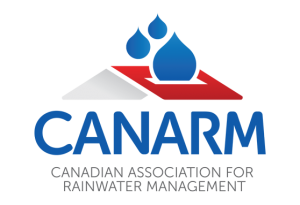 We are also members of CANARM, the Canadian Association for Rainwater Management. CANARM is a resource for education, awareness, training, and connectivity for various groups and individuals involved in the rainwater industry in Canada. We are also very proud that University Sprinklers’ Residential Sales and Service Manager, Whalen Bishop is now a member of the Board of Directors at CANARM. Whalen is very excited about rainwater’s future relationship with irrigation design. Read more about one of his latest projects in the Fall 2013 Newsletter of the Recreational Facilities Association of British Columbia.
We are also members of CANARM, the Canadian Association for Rainwater Management. CANARM is a resource for education, awareness, training, and connectivity for various groups and individuals involved in the rainwater industry in Canada. We are also very proud that University Sprinklers’ Residential Sales and Service Manager, Whalen Bishop is now a member of the Board of Directors at CANARM. Whalen is very excited about rainwater’s future relationship with irrigation design. Read more about one of his latest projects in the Fall 2013 Newsletter of the Recreational Facilities Association of British Columbia.
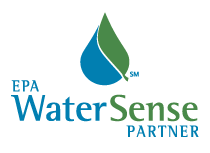 Additionally, our VP David Pfortmueller is a member of the Environmental Protection Agency’s WaterSense Program through the Irrigation Association in the United States.
Additionally, our VP David Pfortmueller is a member of the Environmental Protection Agency’s WaterSense Program through the Irrigation Association in the United States.
Components of a Rainwater Irrigation System
Roof and Gutter System
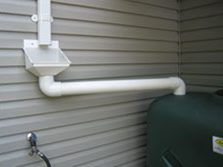 This is where all the action starts! Rainwater falls on the roof, and is transported via the roof and gutter system to the tanks. Considerations include the most efficient capture of all the rainwater, acceptable locations for downspout intercepts, and leaf and other roof debris management. More that one roof or downspout can be used. Some roofs are better than others at catching the rainfall efficiently.
This is where all the action starts! Rainwater falls on the roof, and is transported via the roof and gutter system to the tanks. Considerations include the most efficient capture of all the rainwater, acceptable locations for downspout intercepts, and leaf and other roof debris management. More that one roof or downspout can be used. Some roofs are better than others at catching the rainfall efficiently.First Flush Diverter
Tanks
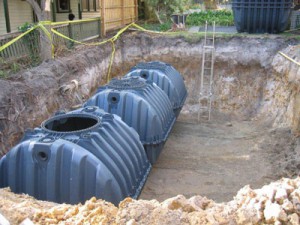 These can be large or small, above ground or buried. Many times multiple tanks are connected together to increase the capacity of the system.
These can be large or small, above ground or buried. Many times multiple tanks are connected together to increase the capacity of the system.Pump
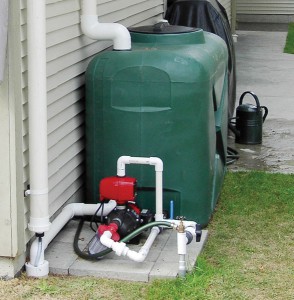 Pumps carry the water from the tank(s) to the irrigation system. They can be submersible (in the tank) or centrifugal (outside the tank). Usually powered by electricity, they will require wiring to the main electrical panel in many cases. Pumps are sized based on a number of factors – the size of the tank, the quantity of head pressure required (psi), the volume of water that is required (GPM). Some of the very low-pressure, low-volume pumps are solar powered.
Pumps carry the water from the tank(s) to the irrigation system. They can be submersible (in the tank) or centrifugal (outside the tank). Usually powered by electricity, they will require wiring to the main electrical panel in many cases. Pumps are sized based on a number of factors – the size of the tank, the quantity of head pressure required (psi), the volume of water that is required (GPM). Some of the very low-pressure, low-volume pumps are solar powered.Filters
Tank Top Ups

